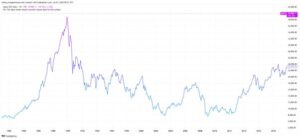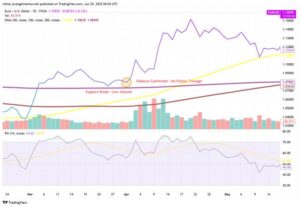Today’s economic calendar includes several key data releases, such as the U.S. API crude oil inventory, the U.K.’s GDP and industrial production figures, and U.S. CPI (Consumer Price Index) numbers. These reports will likely impact the forex, crude oil, precious metals, and stock markets. Let’s break down how these data points might affect market movements.
U.K. GDP and Industrial Production Data
This afternoon, the U.K. will release its GDP monthly rate and industrial production data for July. The forecast suggests that the GDP monthly rate will remain steady at 0.6%, while industrial production is expected to slow to 0.3%, down from 0.8% last month.
These figures are crucial for the British pound. If GDP growth meets or exceeds expectations, it signals a healthy economy, which could strengthen the pound. Conversely, if the numbers fall short, the pound may come under pressure. Industrial production data, which measures the performance of the manufacturing and industrial sectors, is another important indicator. Strong industrial production would suggest economic recovery in those sectors, which could further boost the pound. If the numbers disappoint, the pound might weaken.
Moreover, a rebound in industrial production could also influence global commodity markets, as higher production typically drives up demand for raw materials like metals and energy, potentially increasing their prices.
U.S. CPI Data
One of the most highly anticipated data points today is the U.S. CPI report for August. The CPI tracks changes in consumer prices and is a key indicator of inflation, which directly influences the Federal Reserve’s monetary policy. The market forecast expects CPI to come in at 2.6%, down from 2.9% last month, signaling that inflationary pressures may be easing.
Currently, there’s widespread speculation that the Federal Reserve might begin lowering interest rates as early as September. If the CPI numbers come in as expected or slightly lower, the likelihood of a rate cut increases. This would weaken the U.S. dollar, as lower rates typically reduce demand for the currency, which could push up other currencies like the euro and the pound. A weaker dollar would also support the price of gold, which tends to move inversely to the greenback.
On the other hand, if the CPI data is higher than expected, it won’t necessarily change the market's expectation for a rate cut, but it could cause some uncertainty about the timing. In the short term, the dollar could remain strong, putting pressure on gold and other precious metals.
Furthermore, a rate cut could have a positive effect on U.S. stocks, especially in sectors like technology and real estate, which are sensitive to interest rates. Lower borrowing costs would reduce expenses for these companies, potentially boosting their growth.
API and EIA Crude Oil Inventory Data
Later today, the U.S. will release both API and EIA crude oil inventory reports. The API report is expected to show an increase of 764,000 barrels, after a decrease of 7.4 million barrels last week. If confirmed, this would suggest that crude oil inventories are rising, which could cap oil price gains. Meanwhile, the EIA report is forecast to show a decrease of 1.14 million barrels, signaling tighter supply, which might support oil prices.
Crude oil inventory data is a key indicator for the energy market. If inventories rise, it generally indicates oversupply, which could lead to lower oil prices. Conversely, if inventories fall, it suggests tighter supply and could push oil prices higher. Given the current global economic slowdown and weakened demand, oil prices remain uncertain. The API and EIA data releases could trigger significant market volatility, especially in oil futures and energy-related stocks.
Summary of Market Impact
Today’s economic data will likely impact multiple markets, and investors should keep a close watch to adjust their strategies accordingly:
-
Forex Market: The U.K.’s GDP and industrial production data will directly influence the pound. Strong economic data could push the pound higher, while weaker data might lead to a decline. The U.S. CPI data will affect the dollar—lower-than-expected inflation could weaken the dollar and boost non-dollar currencies like the euro and pound.
-
Precious Metals Market: The U.S. CPI data will have a direct effect on gold and silver prices. Lower inflation could support a rate cut, weakening the dollar and lifting gold prices. Conversely, if inflation is higher than expected, the dollar might strengthen, putting downward pressure on gold.
-
Crude Oil Market: The API and EIA crude oil inventory reports will influence oil prices. A rise in inventories could push prices lower, while a decline in inventories could provide upward pressure. Oil price movements will also affect energy stocks and oil-related investment products like oil futures and energy ETFs.
-
Stock Market: Inflation and economic data will also impact stock markets. Lower inflation and rate cut expectations would likely be positive for the stock market, particularly for interest-rate-sensitive sectors like technology and real estate. Rate cuts reduce borrowing costs, encouraging growth in these industries.
In summary, today’s economic data releases will likely lead to some volatility across markets, particularly in forex, precious metals, and crude oil. Investors should closely follow the data and be prepared to adjust their investment strategies in response to market reactions.





